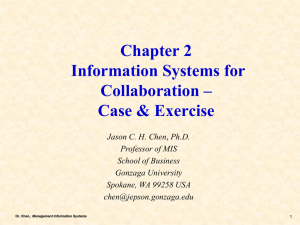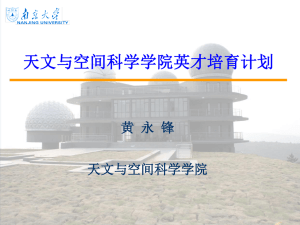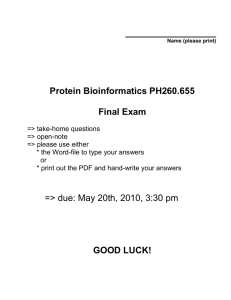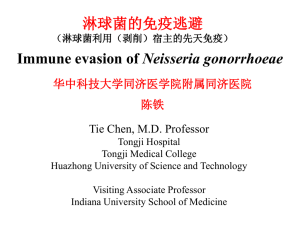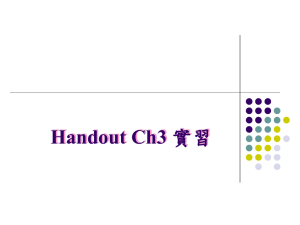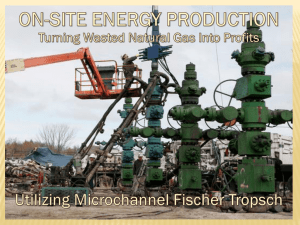PPT - Auburn University
advertisement
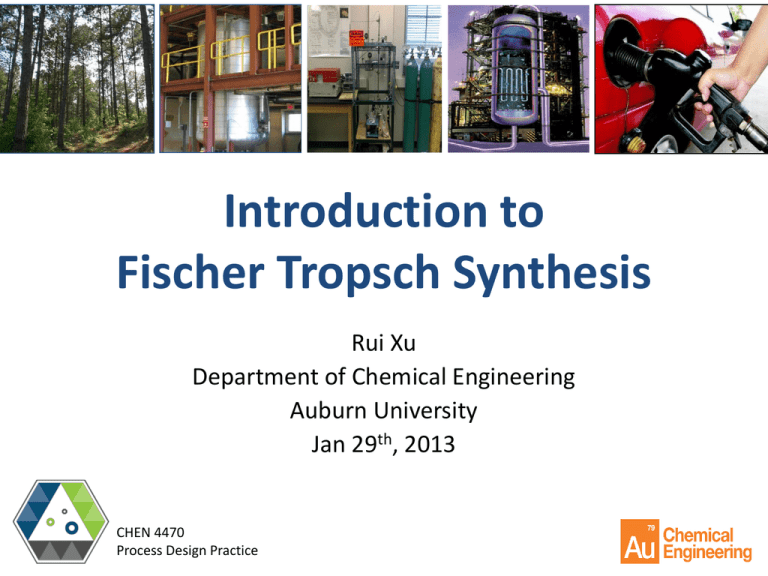
Introduction to Fischer Tropsch Synthesis Rui Xu Department of Chemical Engineering Auburn University Jan 29th, 2013 CHEN 4470 Process Design Practice XTL Technology CHEN 4470 Process Design Practice Coal Biomass Natural Gas L G X Gasification Syngas Processing FischerTropsch Synthesis Syncrude Refining & Upgrading Fuel & Chemicals Natural Gas Gasification CHEN 4470 Process Design Practice Steam Reforming • • • • CH4 + H2O → CO + 3H2 (Ni Catalyst) H2/CO = 3 Endothermic Favored for small scale operations Partial Oxidation • • • • CH4 + ½O2 → CO + 2H2 H2/CO ≈ 1.70 Exothermic Favored for large scale applications Autothermal Reforming • A combination of Steam Reforming and Partial Oxidation Coal Gasification CHEN 4470 Process Design Practice 2(-CH-) + O2 → 2CO + H2 H/C Ratio • Produces Leaner Syngas (Lower H2:CO Ratio) Ash • Non-flammable material in coal complicates Gasifier design Impurities (Sulfur) • Necessitates greater syngas cleanup Biomass Gasification CHEN 4470 Process Design Practice 2(-CH-) + O2 → 2CO + H2 H/C Ratio • Similar issues to coal Ash • Biomass aggressively forms ash Impurities (Sulfur, Nitrogen) • Necessitates greater syngas cleanup Moisture • High moisture levels lower energy efficiency Size Reduction • The fibrous nature of biomass makes size reduction difficult Syngas Processing CHEN 4470 Process Design Practice Water Gas Shift Reaction • CO + H2O ↔ CO2 + H2 Purification • Particulates • Sulfur (<1 ppm) - ZnO Sorbent • Nitrogenates (comparable to Sulfur compounds) • BTX (Below dew point) CHEN 4470 Process Design Practice GTL Technology and Syngas Processing Fischer Tropsch Synthesis CHEN 4470 Process Design Practice Introduction and History Reactions and Products Catalysts and Reactors Mechanism and ASF plot Economy Fischer Tropsch Synthesis CHEN 4470 Process Design Practice Franz Fischer Hans Tropsch • Kaiser Wilhelm Institute, Mülheim, Ruhr • 1920s • Coal derived gases • Aim to product hydrocarbons • Commercialized in 1930s FTS Industrial History CHEN 4470 Process Design Practice Germany • • • U.S.A • 1923, Franz Fischer and Hans Tropsch 1934, first commercial FT plant 1938, 8,000 barrels per day (BPD) 1950, Brownsville, 5,000 BPD South Africa • • 1955, Sasol One, 3,000 BPD 1980, 1982, Sasol Two and Sasol Three, 25,000 BPD Malaysia and Qatar • • 1993, Shell, Bintulu, 12,500 BPD 2007, Sasol, Oryx GTL, 35,000 BPD China, Nigeria etc. Fischer Tropsch Synthesis CHEN 4470 Process Design Practice CO + 2H2 → (CH2) + H2O Fischer Tropsch Synthesis CHEN 4470 Process Design Practice Introduction and History Reactions and Products Catalysts and Reactors Mechanism and ASF plot Economy Reactions in FTS CHEN 4470 Process Design Practice CHEN 4470 Process Design Practice Standard LTFT product distribution CHEN 4470 Process Design Practice Fischer-Tropsch Products Hydrocarbons Types Olefins • • High chemical value Can be oligomerized to heavier fuels Paraffins • • High cetane index Crack cleanly Oxgenates Branched compound (primarily mono-methyl branching) Aromatics (HTFT) Fischer Tropsch Synthesis CHEN 4470 Process Design Practice Introduction and History Reactions and Products Catalysts and Reactors Mechanism and ASF plot Economy Fischer-Tropsch Catalysts CHEN 4470 Process Design Practice Fused Iron Catalysts – HTFT • • • • Alkali promotion needed Products are high olefinic Cheapest Reactor: Fluidized bed Iron oxide 1500 °C K2O MgO or Al2O3 Air Molten Magnetite (Fe3O4) Cooled rapidly Crushed in a ball mill Fused Iron Fischer-Tropsch Catalysts CHEN 4470 Process Design Practice Precipitated iron catalysts - LTFT • • • • Na2CO3 Co-precipitation method Alkali promotion is also important Cost more than fused iron catalyst Reactor: slurry phase or fixed bed Fe(NO3)3 K2CO3 pH = 7 Washing Drying Calcination Precipitate Iron Cat. Fischer-Tropsch Catalysts CHEN 4470 Process Design Practice Supported cobalt catalysts - LTFT • • • • Incipient wetness impregnation method Oxide support: silica, alumina, titania or zinc oxide Products: predominantly paraffins Low resistance towards contaminants Co(NO3)2 Support Drying Calcination Supported Co Cat. CHEN 4470 Process Design Practice Comparison of Co and Fe LTFTS Catalyst FTS Reactors CHEN 4470 Process Design Practice FTS Reactors CHEN 4470 Process Design Practice LTFT Reactors CHEN 4470 Process Design Practice CO + H2 → (CH2) + H2O + 145 kJ/mol 1800 oC Adiabatic Temperature Rise • Fixed Bed (Gas Phase Reaction Media) – Shell SMDS – – – – – Excellent reactant transport Simple design Poor product extraction, heat dissipation Limited scale-up Potential for thermal runaway • Slurry Bed (Liquid Phase Reaction Media) – Sasol SPR – – – – – Thermal uniformity Excellent product extraction Excellent economies of scale Requires separation of wax (media) from catalyst High development cost Fischer Tropsch Synthesis CHEN 4470 Process Design Practice Introduction and History Reactions and Products Catalysts and Reactors Mechanism and ASF plot Economy FTS Polymerization Process Steps CHEN 4470 Process Design Practice Reactant adsorption Chain initiation Chain growth Chain termination Product desorption Readsorption and further reaction FTS Polymerization process steps CHEN 4470 Process Design Practice • Reactant adsorption • Chain initiation • Chain growth • Chain termination • Product desorption • Readsorption and further reaction FTS Polymerization Process Steps CHEN 4470 Process Design Practice FTS Mechanisms • Alkyl mechanism • Alkenyl mechanism • CO insertion • Enol mechanism FTS Mechanisms CHEN 4470 Process Design Practice The Alkyl mechanism 1i). CO chemisorbs dissociatively 1ii). C hydrogenates to CH, CH2, and CH3 2). The chain initiator is CH3 and the chain propagator is CH2 3i). Chain termination to alkane is by α-hydrogenation 3ii). Chain termination to alkene is by β-dehydrogenation FTS Mechanisms CHEN 4470 Process Design Practice – The Alkenyl Mechanism 1i). CO chemisorbs dissociatively 1ii). C hydrogenates to CH, CH2 1iii). CH and CH2 react to form CHCH2 2i). Chain initiator is CHCH2 and chain propagator is CH2 2ii). The olefin in the intermediate shifts from the 2 position to the 1 position 3). Chain terminates to alkene is by α-hydrogenation FTS Mechanisms CHEN 4470 Process Design Practice – The CO Insertion Mechanism 1i). CO chemisorbs non-dissociatively 1ii). CO hydrogenates to CH2(OH) 1iii). CH2(OH) hydrogenates and eliminates water, forming CH3 2i). Chain initiator is CH3, and propagator is CO 2ii). Chain propagation produces RC=O 2iii). RC=O hydrogenates to CHR(OH) 2iv). CHR(OH) hydrogenates and eliminates water, forming CH2R 3i). CH2CH3R terminates to alkane by α-hydrogenation 3ii). CH2CH3R terminates to alkene by β-dehydrogenation 3iii). CHR(OH) terminates to aldehyde by dehydrogenation 3iv). CHR(OH) terminates to alcohol by hydrogenation FTS Mechanisms CHEN 4470 Process Design Practice – The Enol Mechanism 1i). CO chemisorbs non-dissociatively 1ii). CO hydrogenates to CH(OH) and CH2(OH) 2i). Chain initiator is CH(OH) and chain propagator is CH(OH) and CH2(OH) 2ii). Chain propagation is by dehydration and hydrogenation to CR(OH) 3i). chain termination to aldehyde is by desorption 3ii). Chain termination to alkane, alkene, and alcohol, is by hydrogenation FTS Mechanisms - ASF Plot CHEN 4470 Process Design Practice • Propagation is exclusively by the addition of one monomer • αi + bi = 1 (by definition) • Propagation probability is independent of carbon number FTS Mechanisms - ASF Plot CHEN 4470 Process Design Practice α = Rp / (Rp + Rt) 𝑀𝑛 = 1 − α α(𝑛−1) 𝑊𝑛 = 𝑀𝑛 ∗ 𝑛/(1−α) 1 The weight fraction of a chain of length n, Wn, can be measured as a function of the chain growth probability. Wn = nαn-1(1- α) The logarithmic relation is as follows: ln (Wn / n) = nln α + ln((1- α)/ α) CHEN 4470 Process Design Practice Standard FTS Product Distribution FTS Kinetics CHEN 4470 Process Design Practice 𝑚 𝑃𝐻2 𝑃𝐶𝑂 Iron - based FT catalyst 𝑟= Cobalt - based FT catalyst 𝑟= • Iron catalyst: at low conversion (P H2O ≈0 ), the reaction rate is only a 𝑃𝐶𝑂 +𝑎𝑃𝐻2 𝑂 𝑚 𝑃𝐻2 𝑃𝐶𝑂 (1+𝑏𝑃𝐶𝑂 )2 function of hydrogen partial pressure. • The kinetic equations imply that water inhibits iron but not cobalt. • For cobalt catalyst, when the CO partial pressure is very high, (1+bPCO) 2→ (bPCO) 2, the reaction rate is proportional to the ratio of P H2 ⁄PCO . • Both denominators involve partial pressure of CO, indicating CO’s general status being a (reversible) catalyst poison. • Both kinetic equations indicate hydrogenation as the rate-limiting step. Fischer Tropsch Synthesis CHEN 4470 Process Design Practice Introduction and History Reactions and Products Catalysts and Reactors Mechanism and ASF plot Economy FTS Economics CHEN 4470 Process Design Practice Overall Cost Capital Cost • 50% to 65% of total production cost is due to capital cost • $10 per BBL for Natural Gas feedstock, $20 per BBL for Coal or Biomass feedstock Operating Cost • 20% to 25% of total production cost is due to operating costs • $5 per BBL for Natural Gas, $10 per BBL for Coal or Biomass Raw Material Cost • Waste or stranded resources are preferred • At market value ($4.50 / MMBTU), natural gas costs $45 / BBL • At market value ($70 / ton), coal costs $35 / BBL • At market value ($30 / ton), biomass costs $30 / BBL XTL technology Economy CHEN 4470 Process Design Practice • Cost Distribution • NTL case 1: 25% for the gas, 25% for the operations and 50% for the capital • NTL case 2: 15% for the gas, 21% for the operations and 64% for the capital (28% reforming, 24% FTS system, 23% oxygen plant, 13% product enhancement and 12% power recovery) • BTL capital (21% for biomass treatment, 18% for gasifier, 18% for syngas cleaning, 15% for oxygen plant, 1% for water-gas-shift (WGS, CO + H2O → CO2 + H2) reaction, 6% for FTS system, 7% for gas turbine, 11% for heat recovery / steam generation, 4% for other) • Recycle, power and heat integration • CO2 transport and storage Syncrude Upgrading CHEN 4470 Process Design Practice Extraction and Purification • Hydrocracking • Converts light olefins to liquid fuels Other Reactions • Converts wax into liquid fuels Oligomerization • Terminal Olefins, Oxygenates, and FT Wax have high value Alkylation, Isomerization, Aromatization, etc. Polymerization • HTFT ethylene and propylene can be made into polymers Hydrogenation • Promoted fuel stability Reference CHEN 4470 Process Design Practice www.fischer-tropsch.org Book: Fischer Tropsch Technology Review Articles: • • • • The Fischer-Tropsch process 1950-2000 (Dry, 2002) High quality diesel via the Fischer–Tropsch process – a review (Dry, 2001) Kinetics and Selectivity of the Fischer–Tropsch Synthesis: A Literature Review (Gerard, 1999) Design, synthesis, and use of cobalt-based Fischer-Tropsch synthesis catalysts (Iglesia, 1997) CHEN 4470 Process Design Practice



